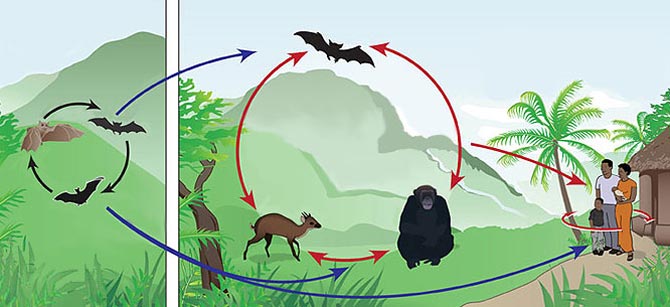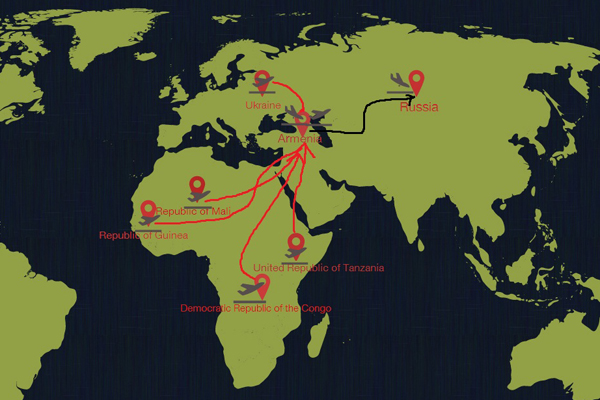
Armenia’s Deadly Dance with Ebola: Will Government Enforce Its Ban on Certain African Animals?
With the deadly Ebola virus running rampant in certain eastern African countries, the Armenian government has said that is taking measures to beef-up security at points of entry into the country.
Surprisingly, official Yerevan doesn’t perceive the threat coming from infected humans entering Armenia, but from animals imported from Africa.
Hovhannes Mkrtchyan, who runs the Veterinary Department at Armenia’s Food Safety Service told Hetq that “we have our hands on the pulse of the problem”, adding that his group is watching the borders day and night.
Armenian officials say that humans are also being subject to examination by specialized equipment monitoring a person’s body temperature. Those suspected of being infested are quarantined and examined in greater detail.
Trade in Animals Poses Real Risk to Armenia
Readers who have been following Hetq’s coverage on the importation, possibly illegal, of various primate species from Africa, especially from Guinea and the Democratic Republic of the Congo (DRC) can understand why Armenia is susceptible to an Ebola outbreak.
According to the World Health Organization, the Ebola virus may be acquired upon contact with blood or bodily fluidsof an infected human or other animal. No specific treatment for the disease is yet available. The disease has a high risk of death, killing between 50% and 90% of those infected with the virus.
 |
| How is the Ebola virus transmitted Photo: www.kakprosto.ru-ից |
Again, according to the WHO, bats are considered the most likely natural reservoir of the EBOV (Ebola virus), one of the four of five viruses classified in the genus Ebolavirus that causes EVD (Ebola virus disease).
Bats drop partially eaten fruits and pulp, then land mammals such as gorillas and duikers feed on these fallen fruits. This chain of events forms a possible indirect means of transmission from the natural host to animal populations.One of the four viruses, RestonEbola virus (REBOV) can also be transmitted to pigs.
The largest outbreak to date is the ongoing 2014 West African Ebola outbreak, which is affecting Guinea, Sierra Leone, Liberia, and Nigeria.
But the history of the Ebola scourge dates back to 1976, when the first reported case was identified in the Democratic Republic of the Congo (then Zaire). The second major outbreak occurred in the same country in 1995.
These are countries directly linked to the animal trade in Armenia.
According to Armenia’s National Statistical Service, 286 primates were imported to Armenia in 2011and 133 in 2012 from around the world.
Hovhannes Mkrtchyan says that in 2013, three primates were brought into Armenia on a circus tour from Ukraine. Two others were imported from Georgia for the Yerevan Zoo. In the same year, an outfit called Zoo Fauna Art imported 28 primates. Mkrtchyan claims that none have been imported so far this year.
These numbers are questionable given what Hetq uncovered earlier this year regarding the importation of endangered animals to Armenia. (See: Dubious Documents: How Endangered Animals Enter Armenia under the Nose of the Ministry)
Many Animal Species Enter Armenia Clandestinely

Hetq revealed that a total of 66 primates have been brought into Armenia, from the DRC and elsewhere, that were never registered with the Veterinary Department of the Food Safety Inspectorate. Never registered means they were never monitored.
Seemingly comprehending the extent of the risk and the fact that Armenia’s medical sector is woefully inadequate to handle such an outbreak, if it were to occur, Armenia has placed a ban on the importation of primates, duikers, bats and hairy pigs from Guinea, Liberia, Sierra Leone and Nigeria before being declared safe.
Will Government Ban be Enough?
The ban also covers imports of these animals originating from the same countries exported to Armenia via third countries.
Mkrtchyan says this list of countries may be expanded in future depending on whether the virus spreads to other nations worldwide.
All these preventative measures taken by Armenia might work if animals were imported to Armenia through legal and official channels. Sadly, this hasn’t been the case.
After Hetq broke the story last November, the Armenian police slapped Zoo Fauna Art company owner Artur Khachatryan with criminal contraband charges regarding the importation of two bonobo primates from Guinea. The case is on-going.
Interpol is also looking into the illegal trade of endangered species via Armenia.
When Hetq published its investigative series of the illegal animal trade in Armenia, Khachatryan told us that one of the bonobos had died seven days after arriving in Armenia.
However, Food Safety Service official Hovhannes Mkrtchyan, who claims that animals imported into Armenia are kept in quarantine for 30 days and monitored for health reasons, assured Hetq that he knew of no case where an animal died while under quarantine.
This leads us to infer that the two bonobos and the 66 other primates entered Armenia surreptitiously; under the radar.
Given the likelihood that this is the case, what are the chances of Ebola infected animals entering Armenia today – government ban or not?
All bets are off on this one.
First photo: www.ibtimes.co.uk
 Videos
Videos Photos
Photos




Write a comment